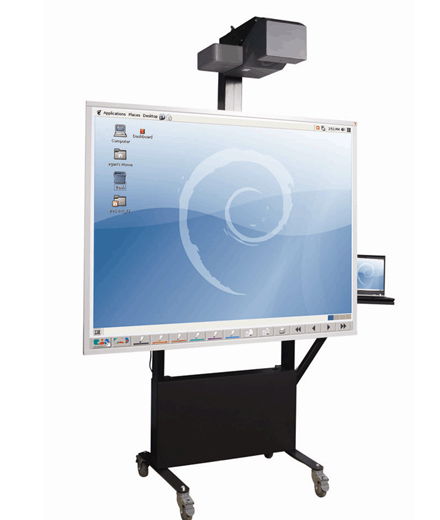Interactive Whiteboards Again

Last week I was lucky to participate in a very interesting event called the CIO Congress “White Nights”. The event was very eventful and interesting, as always, but this is a little different. In addition to all the traditional attributes of conferences, there was also an interactive TeamBoard. So I had a chance to poke my hands into the enemy miracle of technology myself ...
All the operation of the system is described in one word - logically. Everything is thought out in terms of logic, which sometimes conflicts with intuitiveness. But even this does not spoil the impression of work.
So, everything looks more than solid:

A large board, with a very bright short-focus projector (if you don’t know the details, not everyone understands where the picture comes from), with a set of buttons at the bottom of the screen and with the ability to adjust the height of the board (electric lift). The projector is positioned so that it practically does not give shadows when a person is working at the blackboard. Screen taps are tracked using resistive technology. The buttons allow you to select the color of the marker. Ta Dam! When choosing this tool, the following happens: the screenshot becomes the next slide in the program attached to this complex. Logically, but you need to get used to it. At first it knocks down.
The first thing that almost all IT specialists did was to check what would happen if not one hand was used, but two. The answer turned out to be logical, but not obvious - the system calculated the average position for the cursor.

The signal comes from the speaker's platform, on which the laptop and touch screen are located. It is understood that the laptop is closed and everything is controlled through a board or screen with the same success. The tribune is very comfortable, but it is much more pleasant to poke a finger into the board.
If you use standard programs for presenting presentations, it is difficult to fully take advantage of the board, it takes practice to understand which application is used at a particular moment in time. If you use native software, you can enjoy all the possibilities of managing slides, drawing on them and other little things.
Seen cons:
- The touch screen on the podium is not very sensitive.
- It is inconvenient to snap back slides in the presentation if you do not use special devices or a laptop keyboard.
- In order to make full use of all the properties of the board, the presentation slides must be overtaken into the program that comes with the board; accordingly, the advantages of presentation programs are lost.
Nevertheless, this device significantly adds life to the speaker's communication with the audience. When the board was used, there was a feeling of closer communication, the speaker became sort of one of the participants, it was easier for him to ask questions and easier to discuss.
Probably it is for these feelings that people are willing to pay.
If you know about such opportunities in advance, you can significantly diversify the presentation formats. In general, I really liked it.
